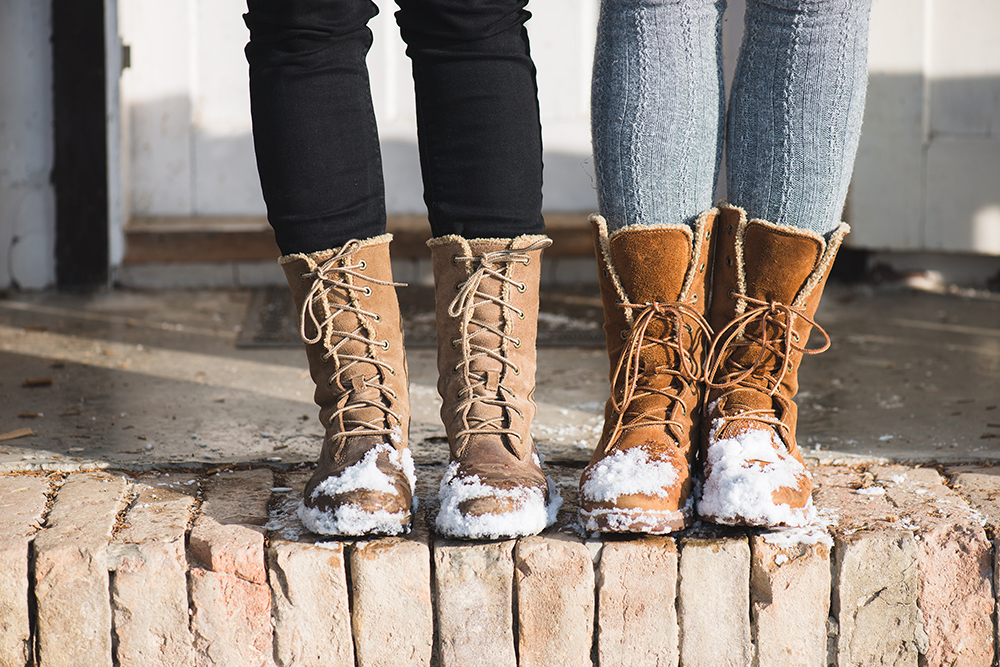Varicose vein and spider vein treatments tend to be more prominent in the winter months. Winter tends to be a better time of year for those who experience problems with venous disease as the heat of summer typically causes the veins to dilate and stretch. This will generally increase the symptoms associated with varicose and/or spider veins.
Compression Therapy
In the winter months, vein patients are much more likely to wear compression stockings or socks, having them act as another layer of insulation. Compression stockings will not completely cure vein issues, but they are able to improve the symptoms and keep the issue from getting worse.
The concept of compression therapy is based on a simple and efficient mechanical principle consisting of applying an elastic garment around the leg. By compressing the limb with graduated compression (strongest at the ankle and decreasing going up the leg), the compression stocking acts as a layer of muscle by gently squeezing the stretched vein walls together, allowing the valves to close. The cavity of the vein is reduced, thereby restoring blood flow to a normal state and aiding overall circulation.
There are two common types of compression therapy:
- Compression Stockings: The usual first line of therapy (especially per most insurance companies) is entirely non-invasive. When applied, high-pressure stockings may prohibit veins, closer to the surface, from pooling.
- Unna Boot: Unna Boots are useful in healing leg wounds and ulcers. These ‘boots’ are compression gauze that contains zinc oxide paste to further aid the healing process.
Regular Activity
Many people prefer to stay inside during the colder months. A lifestyle with less activity and more sitting around could increase the symptoms associated with the varicose or spider veins. Excessive sitting increases the pressure in the legs and can cause the blood in unhealthy veins to pool more quickly. Keep the legs active as much as possible during the winter months by:
- Getting up and walking around the house/office multiple times a day
- Mall walking around the holidays
- Riding a stationary bike
- Elevating your legs if you have to sit/lay for an extended period of time
- Don’t cross your legs while sitting, if necessary cross your legs at the ankles
Each patient’s condition is unique. For this reason, we offer an initial complimentary* vein screening to evaluate each patients condition so that we can recommend the appropriate treatment protocol. The following is reviewed in the initial complimentary* vein screening:
- Medical History
- Visual Exam
- Recommendation for Venous Ultrasound (if needed)
- Review of Diagnosis
- Treatment Options (will depend on Ultrasound results)
*Additional diagnostic ultrasound testing may be required, which will be billed to the insurance carrier.
Call our office or visit our website to learn more and schedule a free screening today!
Varicose vein and spider vein treatments tend to be more prominent in the winter months. Winter tends to be a better time of year for those who experience problems with venous disease as the heat of summer typically causes the veins to dilate and stretch. This will generally increase the symptoms associated with varicose and/or spider veins.
Compression Therapy
In the winter months, vein patients are much more likely to wear compression stockings or socks, having them act as another layer of insulation. Compression stockings will not completely cure vein issues, but they are able to improve the symptoms and keep the issue from getting worse.
The concept of compression therapy is based on a simple and efficient mechanical principle consisting of applying an elastic garment around the leg. By compressing the limb with graduated compression (strongest at the ankle and decreasing going up the leg), the compression stocking acts as a layer of muscle by gently squeezing the stretched vein walls together, allowing the valves to close. The cavity of the vein is reduced, thereby restoring blood flow to a normal state and aiding overall circulation.
There are two common types of compression therapy:
- Compression Stockings: The usual first line of therapy (especially per most insurance companies) is entirely non-invasive. When applied, high-pressure stockings may prohibit veins, closer to the surface, from pooling.
- Unna Boot: Unna Boots are useful in healing leg wounds and ulcers. These ‘boots’ are compression gauze that contains zinc oxide paste to further aid the healing process.
Regular Activity
Many people prefer to stay inside during the colder months. A lifestyle with less activity and more sitting around could increase the symptoms associated with the varicose or spider veins. Excessive sitting increases the pressure in the legs and can cause the blood in unhealthy veins to pool more quickly. Keep the legs active as much as possible during the winter months by:
- Getting up and walking around the house/office multiple times a day
- Mall walking around the holidays
- Riding a stationary bike
- Elevating your legs if you have to sit/lay for an extended period of time
- Don’t cross your legs while sitting, if necessary cross your legs at the ankles
Each patient’s condition is unique. For this reason, we offer an initial complimentary* vein screening to evaluate each patients condition so that we can recommend the appropriate treatment protocol. The following is reviewed in the initial complimentary* vein screening:
- Medical History
- Visual Exam
- Recommendation for Venous Ultrasound (if needed)
- Review of Diagnosis
- Treatment Options (will depend on Ultrasound results)
*Additional diagnostic ultrasound testing may be required, which will be billed to the insurance carrier.
Call our office or visit our website to learn more and schedule a free screening today!

